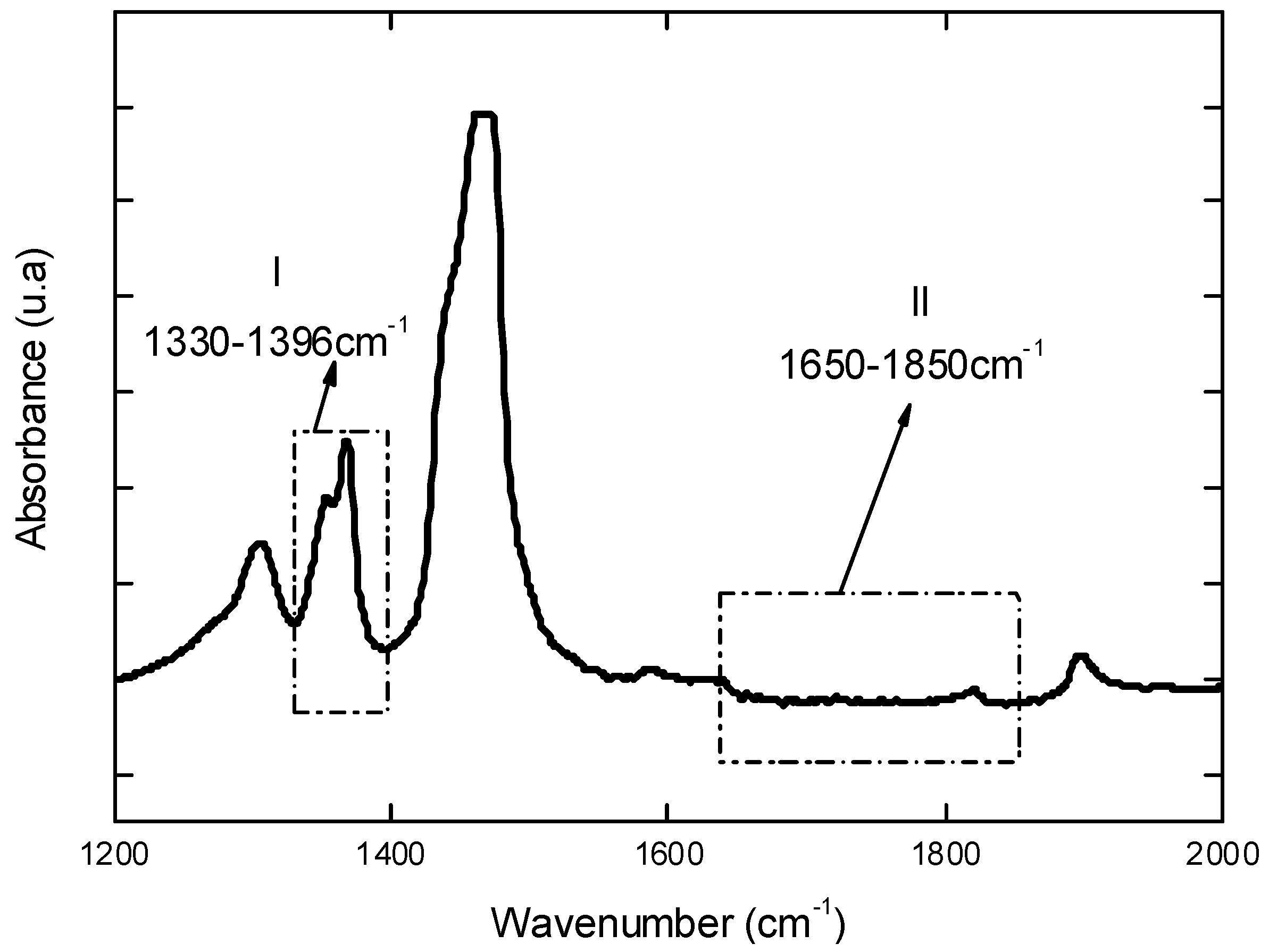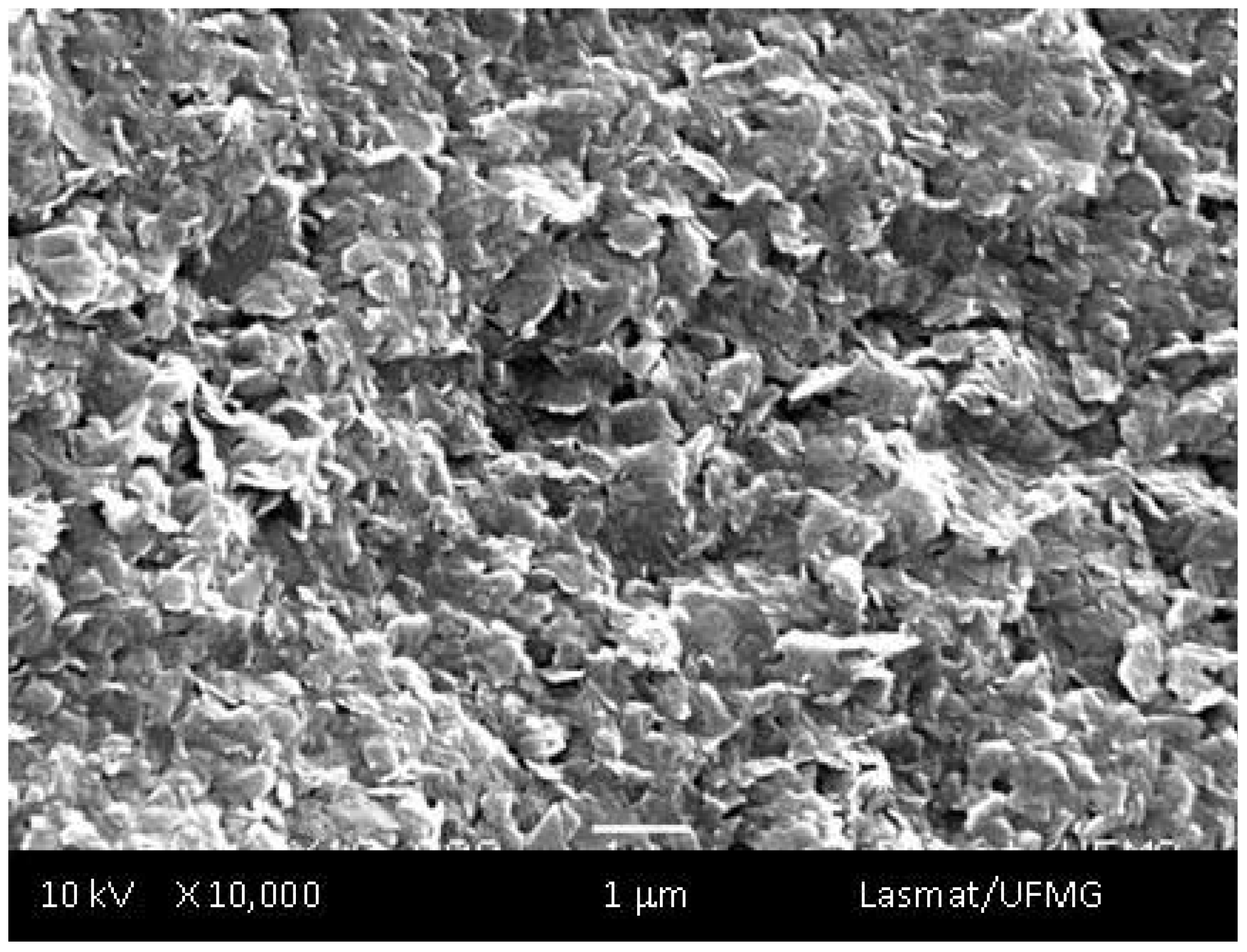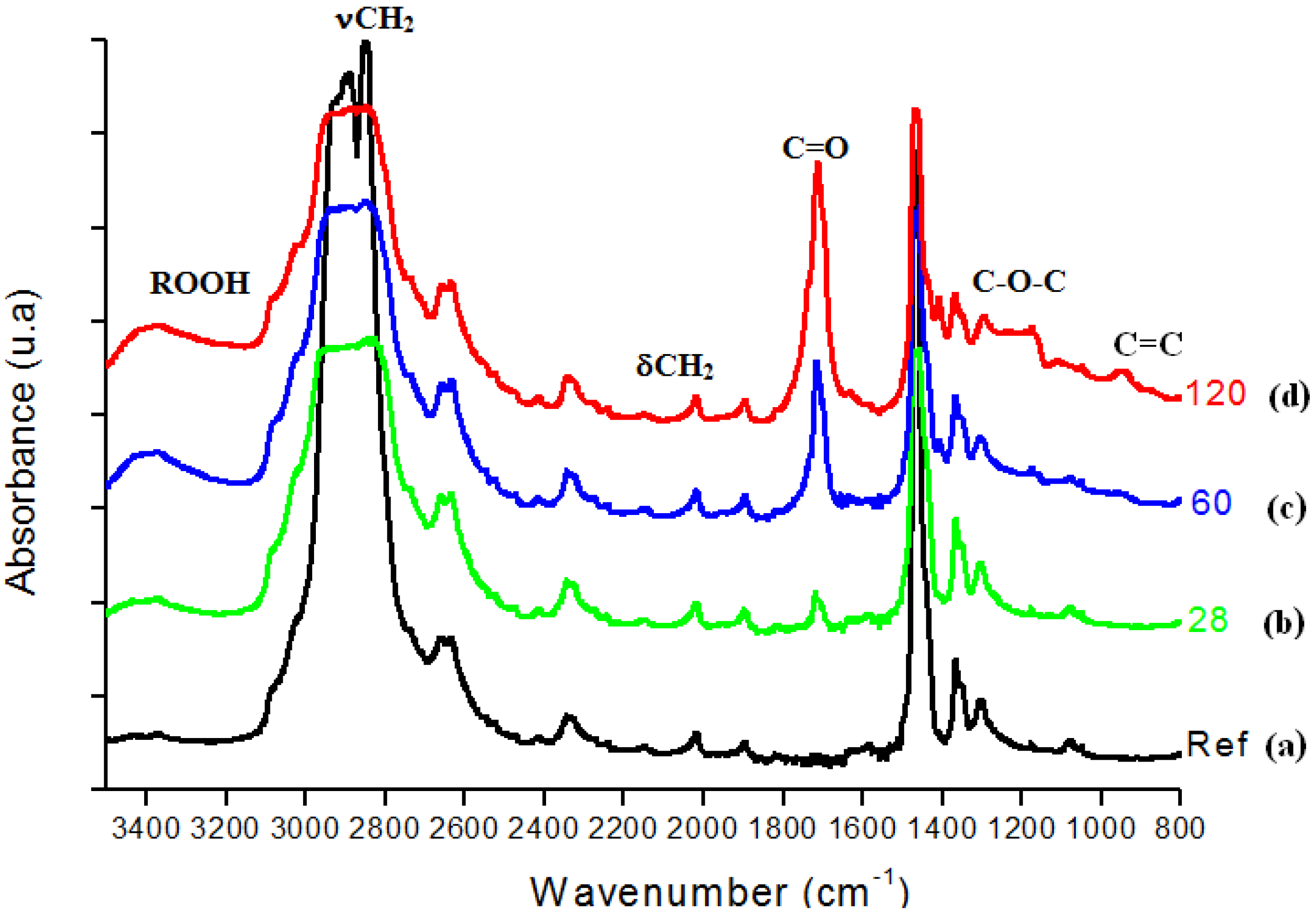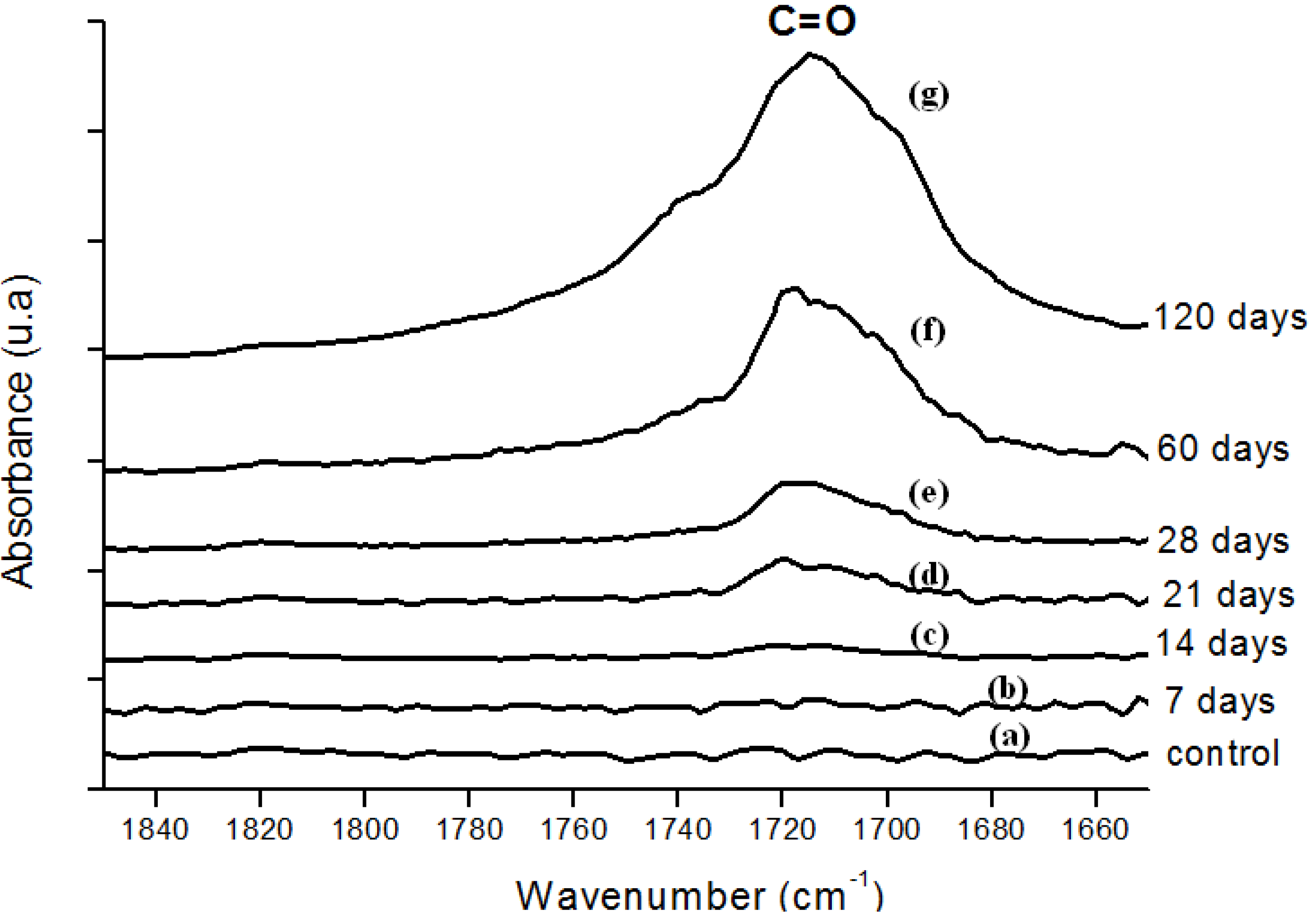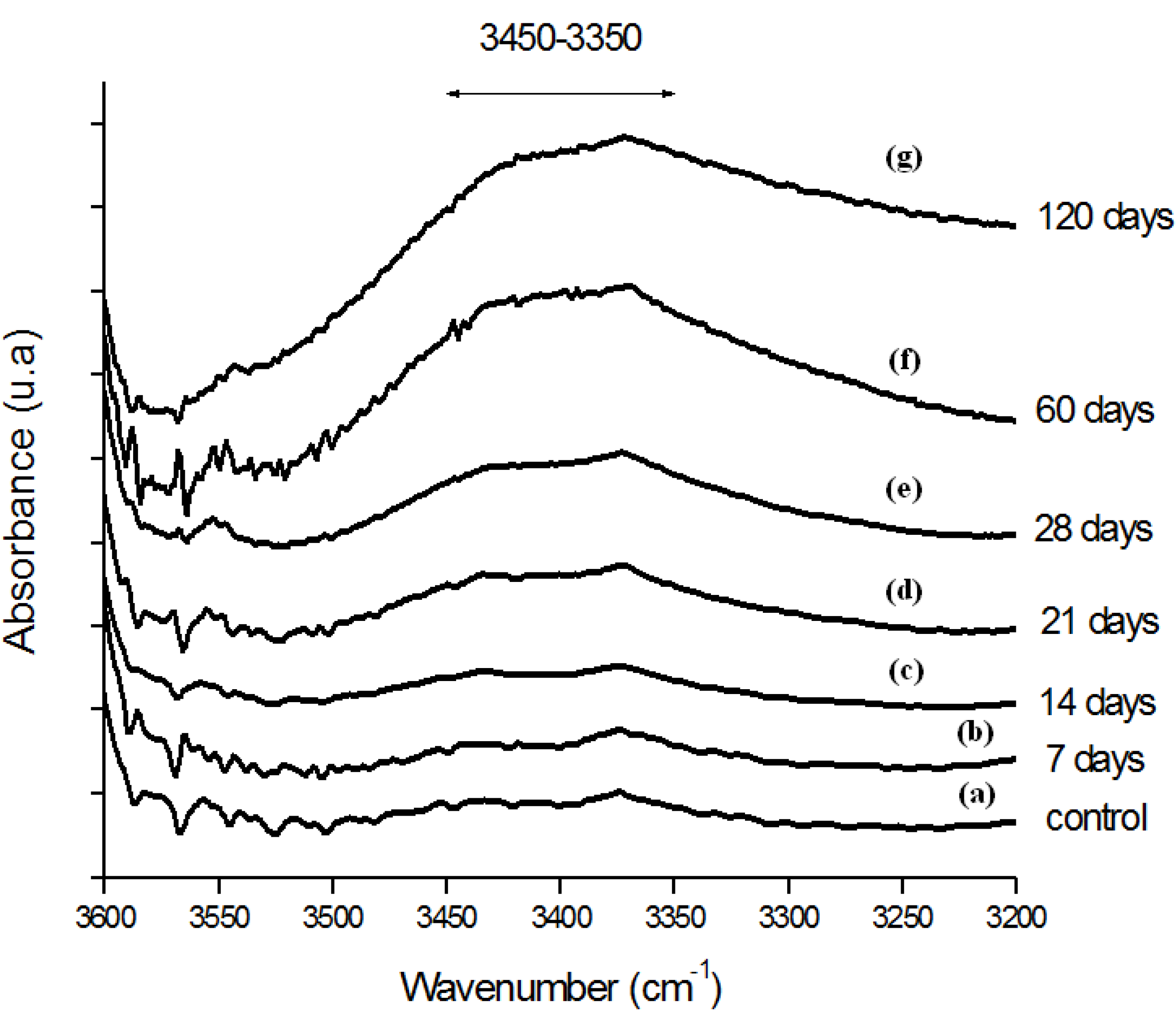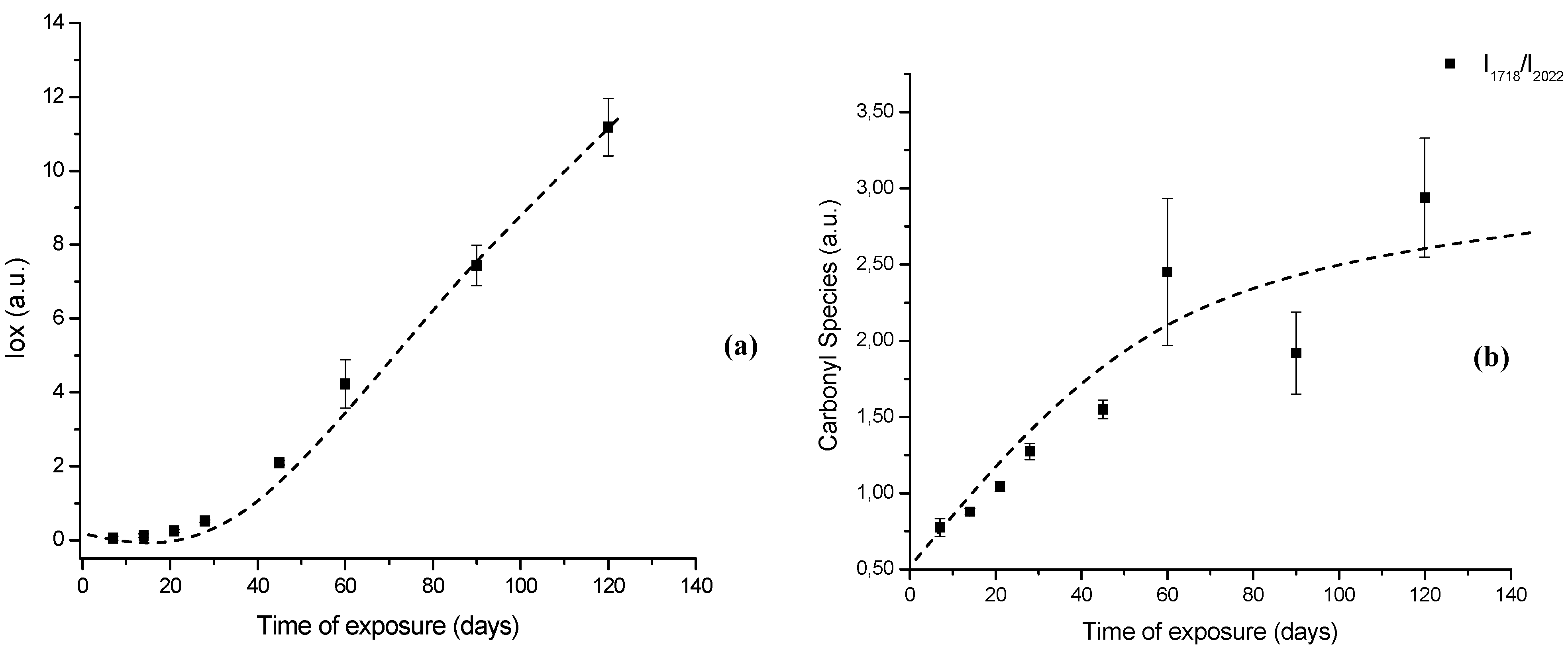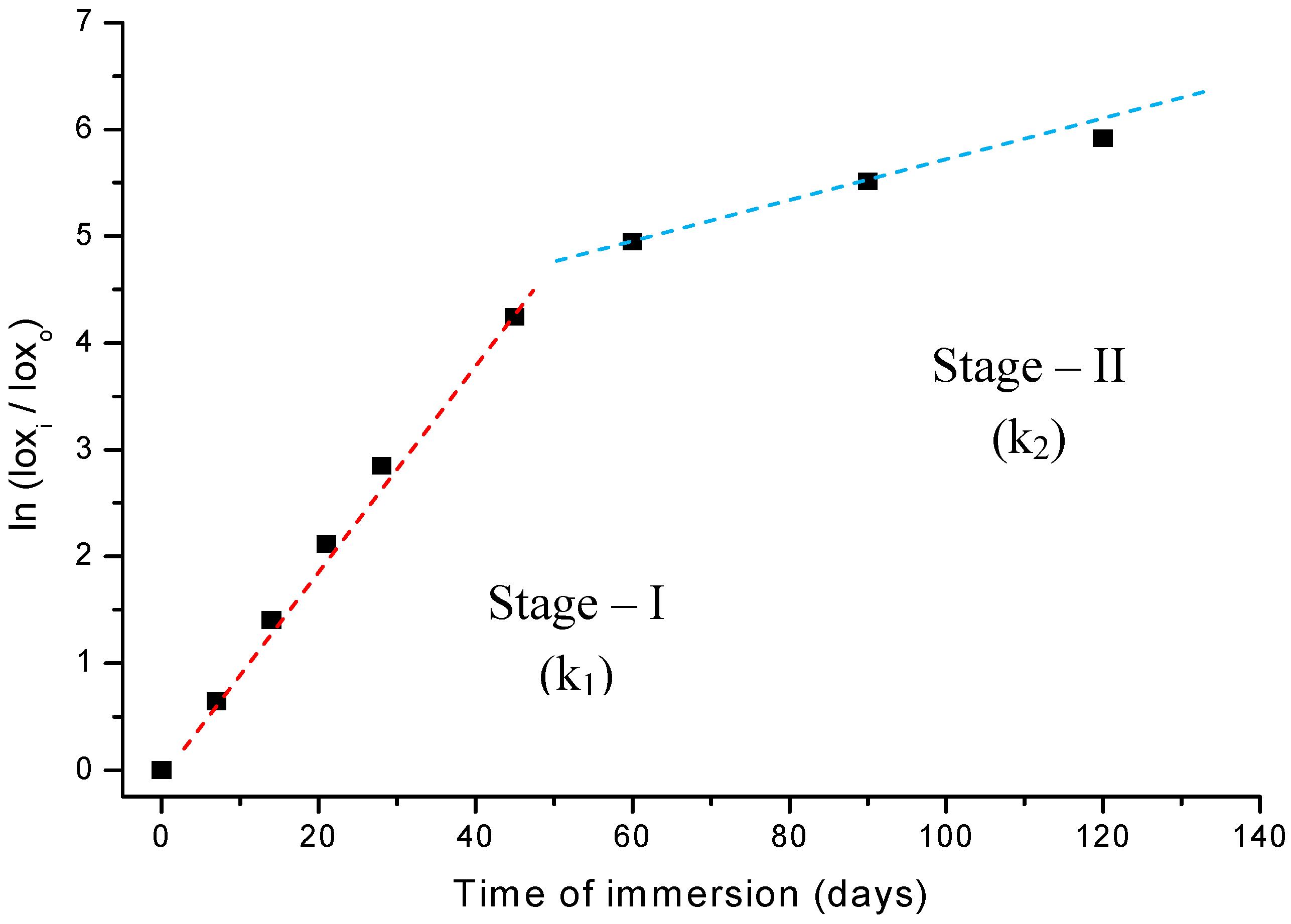2.2.1. Oxidizer Generation – Background
Despite the intensive focus on ageing methodologies for UHMWPE there remains much debate over the most effective way to accelerate ageing of this material. Many studies have analyzed the changes in UHWMPE after irradiation and natural aging [
5,
6,
8,
9,
10,
11]. However, in-depth analysis in terms of physico-chemical aspects, for instance oxidation index, crystallinity, formation of radicals, reaction kinetics and pathways are not yet totally understood. H
2O
2 is one of the most powerful oxidizers known. Also, through catalysis, H
2O
2 can be converted into hydroxyl radicals (•OH) with have very high reactivity. Hydrogen peroxide always decomposes spontaneously and exothermically into water and oxygen gas (Equation 1):
This process is very thermodynamically favorable (ΔH° = −98.2 kJ mol−1; ΔG° = −119.2 kJ mol−1; ΔS = 70.5 J mol−1 K−1). The rate of decomposition is dependent on the temperature and concentration of the peroxide, as well as the pH. Furthermore, the theory supports by a vast body of experimental evidence that aerobic organisms generate powerful pro-oxidant species such as hydrogen peroxide. Consequently, the oxidation by hydrogen peroxide solution was used as an accelerated aging procedure and samples were collected at different time intervals.
2.2.2. FTIR Spectroscopy – Oxidation
FTIR spectroscopy was used for characterizing the oxidized UHMWPE samples (UHMWPE-Ox). In
Table 1, some major bands usually associated with oxidative degradation of UHMWPE according to the broadly reported literature [
6,
7,
8,
9,
10,
11,
16,
17,
18,
19,
20] are presented. The UHMWPE-Ox samples have exhibited some of these absorption bands after being submitted to the aging assays.
Table 1.
Major FTIR bands associated with UHMWPE and its oxidized species.
Table 1.
Major FTIR bands associated with UHMWPE and its oxidized species.
| Band Region (cm-1) | Description | Reference |
|---|
| 3,450 – 3,350 | Hydroperoxide and alcohol | [6,10,11,19] |
| 1,710 – 1,740 | Carbonyl species: ketones, carboxylic acid, aldehydes, | [9,10,11] |
| 1,100 – 1,400 | Ethers and other –C-O-C groups | [9,10,11] |
| 800 – 1,000 | Unsaturated bonds, trans-vinylene groups | [6,10,11] |
In
Figure 3, FTIR spectra from UHMWPE before and after 28, 60, 120 days of accelerated aging in hydrogen peroxide are presented. The main changes in the FTIR spectra upon oxidation of polyethylene samples involved the formation of typical products such as isolated hydroperoxides (3,550 cm
-1), hydrogen bonded hydroxyls including hydroperoxides (3,410 cm
-1), lactones (1,860 cm
-1), esters (1,740 cm
-1), acids and ketones (1,710 – 1,720 cm
-1). In addition, an increase in the absorbance in the 1,400 – 1,180 cm
-1 region associated with –C-O-C vibrations and in the region from 800 – 1,100 cm
-1 mostly related to unsaturated C=C groups was noted.
Figure 4 refers to the main peak in the FTIR spectra in the 1,700 – 1,750 cm
-1 region, corresponding to the strong signal of carbonyl (C=O) groups, which is rather dependent of specimen degradation. A significant absorbance increase was observed in the test period from 7 up to 120 days. The carbonyl functional group is common to several chemical species, for instance ketones, esters, carboxylic acids and lactones, among others. Thus, such results provide strong evidence that UHMWPE oxidation has taken place via chemical reactions of the polyethylene chain with hydrogen peroxide from the aging solution.
Figure 3.
(a) FTIR spectra of reference UHMWPE and UHMWPE oxidized for (b) 28 days, (c) 60 days and (d) 120 days.
Figure 3.
(a) FTIR spectra of reference UHMWPE and UHMWPE oxidized for (b) 28 days, (c) 60 days and (d) 120 days.
Figure 4.
(a) FTIR spectra in the carbonyl (C=O) region of reference UHMWPE and UHMWPE submitted to peroxide accelerated ageing for different periods of time: (b) 7 days; (c) 14 days; (d) 21 days; (e) 28 days; (f) 60 days and (g) 120 days.
Figure 4.
(a) FTIR spectra in the carbonyl (C=O) region of reference UHMWPE and UHMWPE submitted to peroxide accelerated ageing for different periods of time: (b) 7 days; (c) 14 days; (d) 21 days; (e) 28 days; (f) 60 days and (g) 120 days.
Moreover, the hydroperoxide-specific IR vibrational region also supports these findings, as shown in
Figure 5. The FTIR spectra in
Figure 6 shows the evolution of the C-O-C and trans-vinylene (CH=CH) bands as the UHMWPE oxidation time is increased up to 120 days. A similar trend was observed for all chemical groups investigated, that means, carbonyl, hydroperoxides and vinylenes species have showed remarkably higher content for longer oxidation time. In general, almost no detectable oxidation could be observed in the first 7-days period. After that, the oxidation has increased considerably in the timeframe analyzed.
In order to perform a more in-depth investigation of the UHMWPE degradation as far as quantitative analysis was concerned, the spectral regions recommended by ISO 5834-4 (2005) were used to estimate the oxidation degree. The total oxidation index (Iox) was calculated as described in the
“Experimental Section” (Equation 5). Also, the specific carbonyls region was monitored and another parameter calculated according to Equation 6 in the
“Experimental Section” (I
C=O). The I
C=O is mainly due to the presence of ketones estimated from absorbance ratio (as peak heights) between the C=O stretching (νC=O) component of ketones at 1,710 – 1,720 cm
-1 and the band at 2,022 cm
-1 from the CH
2 bending vibrations (internal standard, δCH
2, “twist” bend ) which has been reported in the literature [
7,
8,
9,
10,
11]. The results with data from 7, 14, 28, 45, 60 and 120 days test periods are shown in
Figures 7a,b. The curve 7a, based on the overall reaction (Iox), clearly indicated that oxidation of the UHMWPE has taken place, with a slow evolution up to approximately 28 days. Then, a steep rise could be observed up to 120 days of evaluation. Those oxidation index (Iox) values are supported by reported research on retrieved prosthesis after degradation and severe inflammation processes under patient use. On the other hand, curve 7b related to specific carbonyls (I
C=O) monitored by FTIR has indicated a steady and constant increase on concentration from the early beginning until approximately 45 days, then followed by a gradual reduction up to 120 days. Hence, FTIR has proven to be an important tool, not only for investigating UHMWPE degradation, but also providing relevant information concerning reaction kinetics and mechanism.
Figure 5.
(a) FTIR spectra in the hydroperoxides (ROOH) region of reference UHMWPE and UHMWPE submitted to peroxide accelerated ageing for different period of time (b) 7 days; (c) 14 days; (d) 21 days; (e) 28 days; (f) 60 days and (g) 120 days.
Figure 5.
(a) FTIR spectra in the hydroperoxides (ROOH) region of reference UHMWPE and UHMWPE submitted to peroxide accelerated ageing for different period of time (b) 7 days; (c) 14 days; (d) 21 days; (e) 28 days; (f) 60 days and (g) 120 days.
Figure 6.
(a) FTIR spectra in the ether (-C-O-C-) and trans-vinylene (-CH=CH-) regions of reference UHMWPE and UHMWPE submitted to peroxide accelerated ageing for different periods of time: (b) 7 days; (c) 14 days; (d) 21 days; (e) 28 days; (f) 60 days and (g) 120 days.
Figure 6.
(a) FTIR spectra in the ether (-C-O-C-) and trans-vinylene (-CH=CH-) regions of reference UHMWPE and UHMWPE submitted to peroxide accelerated ageing for different periods of time: (b) 7 days; (c) 14 days; (d) 21 days; (e) 28 days; (f) 60 days and (g) 120 days.
Figure 7.
(a) Evolution of UHMWPE degradation in H2O2 estimated by FTIR using the Oxidation Index (Iox) at different aging times. (b) Specific carbonyl group index (IC=O) related to polymer oxidation up to 120 days.
Figure 7.
(a) Evolution of UHMWPE degradation in H2O2 estimated by FTIR using the Oxidation Index (Iox) at different aging times. (b) Specific carbonyl group index (IC=O) related to polymer oxidation up to 120 days.
2.2.3. Kinetics and Mechanism of UHMWPE Oxidation by FTIR Spectroscopy
The reaction kinetics was investigated in order to obtain a better understanding of the oxidation of UHMWPE. It should be pointed out that a complete investigation of kinetics and mechanism is beyond the scope of the present research. Nevertheless, a preliminary analysis is proposed, aiming to address the long term performance of UHMWPE under peroxide activity. The essential assumption relies on first order reactions. Hence, it would be modeled as Equations 2 and 3:
where k is a temperature-dependent rate constant; t is the reaction time; [A]
0 is the initial concentration of oxidized specie; [A] is the instantaneous concentration of oxidized specie at any time.
Thus, if the UHMWPE degradation via an oxidation reaction in peroxide follows first-order kinetics, a plot of ln (A/A
0) against time will be linear, with slope k as the reaction constant parameter. Indeed, the results shown in
Figure 8 fit the expected behavior remarkably, when the whole oxidation curve is interpreted as a two-stages pattern. In other words, it should be analyzed as two separate first-order reactions, with two different slopes. The linear regression from the first-stage up to 45-days (stage-I) has given a very good curve fitting to the data points with parameters R
2 = 0.99 and k
1 = 1.11E
-5 s
-1. The second-stage (stage-II) values were R
2 = 0.98 and k
2 = 1.86E
-6 s
-1, from 60 to 120 days of reaction. As the peroxide concentration in solution and temperature (37 ºC) were maintained unaltered during the whole experiments, it is reasonable to attribute such strong change in the reaction rate (of about 600%) to a variation in the oxidation mechanism on passing from stage-I to stage-II. Therefore, they must have quite different activation energy (Ea) as showed by Arrhenius Equation (equation 4):
As k1 ≅ 6. k2, thus, Ea1 < Ea2. That means, the activation energy at the first stage (Ea1) is lower than that at longer ages (Ea2, stage-II). The difference can be estimated from (4) where: R = 8.31451 J mol-1 K-1, T=335 K, Δea = RT ln(k1/ k2) and ΔEa= (Ea1 – Ea2) = -5.0 kJ mol-1
These results are supported by assuming a very short induction period related to the initial decomposition of hydrogen peroxide and the formation of hydroperoxy radicals. Because of the very high initial concentration of hydrogen peroxide (~ 8.8 mol L
-1) its decomposition into radicals (•OH) is expected to be rather fast. Then, the polymer chain would be readily attacked and broken at the surface by these just formed radicals leading to the formation of hydroperoxides. In addition, the surface energy is always favorable to reactions due to defects, incomplete bonds, higher mobility of atoms at the liquid-solid interface. Such hypotheses have been reported by other authors such as in the studies of the oxidative degradation mechanism of polyethylene material by Gugumus [
16]. Despite the absence of a consensus about the UHMWPE degradation mechanism there is full agreement that the oxidation of polyolefins involves the formation and decomposition of hydroperoxides as metastable species. These hydroperoxide intermediates may undergo cascading reaction routes causing the appearance of several sub-products such as alcohols, aldehydes, carboxylic acids, ketones, esters, ethers, unsaturated bonds such as trans-vinylene or cyclic species like gamma-lactones [
5,
6,
10,
11,
16,
17,
18,
19,
20,
21]. That would be the overall trend for stage-I in the oxidation pattern of UHMWPE. Then, as the UHMWPE is damaged by the growing number of oxidized species, at the surface and near-surface depth, the original organized structure of polymer chain is exponentially disordered, the degraded layer is thicker, causing a drastically decrease on the oxidation rate as verified in stage-II. Associated with that, some polymer chain crosslinking might be expected and the restricted diffusion of oxygen and oxidizing radicals through the high dense and linear UHMWPE network would most likely cause the oxidation kinetic rate to sharply drop. Our results are consistent with the literature [
3,
8,
12,
16,
17,
18,
19,
20,
21,
22,
23] which has shown that there is a distinct threshold of oxidation index values that must be exceeded in order to observe important alterations at the concentration of oxidized species generated in UHMWPE materials. Deeper into the UHMWPE there will be less oxygen available for reaction, so most of the radicals will combine to produce cross-links. In summary, in stage-I the kinetic mechanism is mostly controlled by surface reactions and in stage-II it is mainly determined by “bulk” (volume) reactions, as supported by k
1 > k
2 and ΔEa < 0 or Ea
1 < Ea
2.
Figure 8.
Study of reaction kinetics associated with the oxidation of UHMWPE in H2O2.
Figure 8.
Study of reaction kinetics associated with the oxidation of UHMWPE in H2O2.
2.2.4. Morphology and Structure UHMWPE Oxidation by SEM
Morphological differences among the UHMWPE samples before and after 60 and 120 days of oxidation in hydrogen peroxide solution can be observed in the SEM images presented in
Figures 9a,b,c. It is evident that a transition from a surface with random roughness (
Figure 9a, before oxidation) to a smoother surface while increasing the accelerated aging time of oxidation (
Figure 9b,c) has taken place. In addition, the samples oxidized for 60 and 90 days showed delamination, pitting and cracks on their surface (
Figures 9b,c). Medel and co-workers [
8] pointed out that despite the oxidative reaction the degradation is mostly associated with the increase on levels of pitting and delamination, which will cause premature failure of the components. Thus, the oxidation of UHMWPE is a rather complex system justifying the intense research in the field in the last 2 – 3 decades. Despite the abundant literature, it is yet not fully understood how much the “
in vivo” degradation will depend not only on the material composition and processing, but if it is a multifactorial result from the patient metabolism, gender, age, dynamic behavior and activities, surgical procedure and so forth.
Based on the FTIR and SEM results, it was verified that the changes in UHMWPE induced by H2O2 ambient reasonably resemble the chemical species and the morphological and structural alterations caused by shelf and in vivo oxidation. Despite the fact that H2O2 is more severe with regards to the oxidative potential than the conditions usually used for the heating protocols, this approach has a significant advantage because it can successfully oxidize unsterilized UHMWPE, which cannot be done under other reported acceleration conditions. Hence, these findings open up interesting alternatives whereby such a method can be used to compare and rank the oxidation response of different resin types, sterilization methods, environment during sterilization and packaging, process support, and thermal stabilization. Also, it may be a useful tool on monitoring and controlling the quality of UHMWPE related to common variations in the manufacturing process. Moreover, the accelerated aging procedure based on H2O2 would be a feasible choice for investigating the behavior of novel UHMWPE-derived materials with incorporated anti-oxidant agents like α-tocoferol and others.
Figure 9.
(a) SEM images of UHMWPE reference sample; UHMWPE oxidized with H2O2 for (b) 60 days and (c) 120 days (at 2,500 X magnifications).
Figure 9.
(a) SEM images of UHMWPE reference sample; UHMWPE oxidized with H2O2 for (b) 60 days and (c) 120 days (at 2,500 X magnifications).
